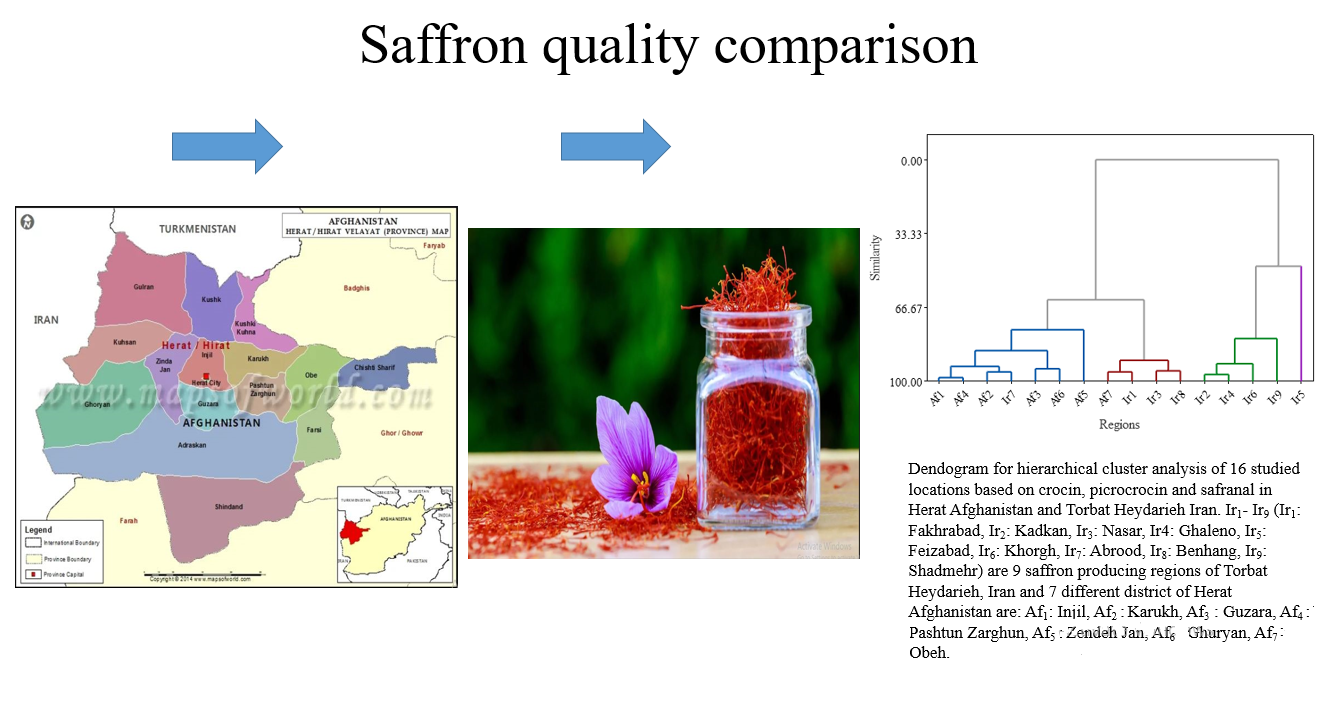Comparison quality parameters of saffron (Crocus sativus L.) produced in Herat, Afghanistan and Torbat Heydarieh, Iran

Published 2024-04-04
Keywords
- Crocin,
- picrocrocin,
- safranal,
- secondary metabolites,
- spectrophotometric analysis
How to Cite
Copyright (c) 2024 Hassan Feizi, Ramin Nazarian, Mehdi Nasiri Mahalati, Hossein Sahabi

This work is licensed under a Creative Commons Attribution 4.0 International License.
Abstract
Saffron Crocus sativus L. (Iridaceae) is one of the most valuable and expensive medicinal plants in the world. In order to compare the quality characteristics of saffron in Afghanistan and Iran, samples of dried C. sativus from different saffron-producing regions of Herat province (Afghanistan) and Torbat Heydarieh county (Iran) were collected in the year 2021. The experiment was analyzed in GLM format and Nested method with three replications. The samples of saffron produced from seven different districts of Herat province in Afghanistan, including Injil, Karukh, Guzara, Pashtun Zarghun, Zendeh Jan, Ghoryan, Obeh and nine saffron-producing villages (Fakhrabad, Kadkan, Nasar, Ghaleno, Feizabad, Khorgh, Abrood, Benhang, Shadmehr) of Torbat Heydarieh county in Iran were examined. The results showed that the effect of country and region (districts and villages) on the quality traits of saffron (crocin, picrocrocin and safranal) was significant. Moreover, the comparison of the mean values indicated the presence of significant differences in the qualitative characteristics of saffron among the different investigated villages of Torbat Heydarieh. The saffron produced in Afghanistan had the highest amount of crocin (on average 279.1 ɷ 440nm) and picrocrocin (on average 101 ϕ 257nm), while the highest value of safranal (on average 34.2 θ 330nm) was observed in saffron samples produced in Iran. The highest amount of the above quality traits belonged to the saffron of Zendeh Jan Herat region 5 (Af5, crocin: 303 ɷ 440 nm, picrocrocin: 106 ϕ 257 nm, safranal: 33 θ 330 nm), while the five Torbat Heydarieh villages had the lowest quality of saffron (Ir5, crocin: 164 ɷ 440nm, picrocrocin: 71 ϕ 257 nm, safranal: 34 θ 330 nm). In the comprehensive analysis of saffron-producing regions in Afghanistan and Iran, in terms of the qualitative attributes (crocin, picrocrocin, and safranal) it was evident that regions 1 to 6 in Herat, Afghanistan (Af1, Af2, Af3, Af4, Af5, Af6) and the Abrood village of Torbat Heidarieh, Iran (Ir7) formed a distinct cluster, demonstrating superior quality compared to other regions. Furthermore, with the exception of the Feizabad village of Torbat Heydarieh (Ir5), all examined samples surpassed the saffron ISO international standard and were categorized as first-grade quality. The exceptional quality of Herat saffron from Afghanistan is likely attributable to the unique geographical features, virgin lands, and specific climatic conditions across diverse cultivation areas.




